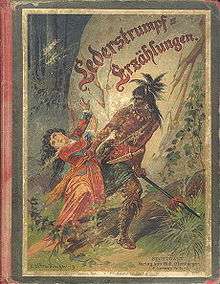Leatherstocking Tales


The Leatherstocking Tales is a series of five novels by American writer James Fenimore Cooper. Each novel features Natty Bumppo, known to European settlers as "Leatherstocking," "The Pathfinder," and "the trapper"; to Native Americans he is known as as "Deerslayer," "La Longue Carabine" and "Hawkeye."
Publication history
| Publication Date | Story Dates | Title | Subtitle |
|---|---|---|---|
| The Deerslayer | The First War Path | ||
| The Last of the Mohicans | A Narrative of 1757 | ||
| The Pathfinder | The Inland Sea | ||
| The Pioneers | The Sources of the Susquehanna; A Descriptive Tale | ||
| The Prairie | A Tale |
The "Story Dates" are derived from dates given in the tales, but do not necessarily correspond with the actual dates of the historical events described in the series. This may have been done for convenience's sake, for instance to avoid making Leatherstocking 100 years old when he traveled the Kansas plains in The Prairie.
The Natty Bumppo character is generally believed to have been inspired, at least in part, by the real-life Daniel Boone or the lesser known David Shipman.[1]
Characters
- Natty Bumppo is the protagonist of the series: an Anglo-American raised in part by Native Americans, and later a near-fearless warrior (his chief weapon is the long rifle). He and his Mohican "brother" Chingachgook are constant companions. He is known as "Deerslayer" in The Deerslayer, "Hawkeye" and "La Longue Carabine" in The Last of the Mohicans, "Pathfinder" in The Pathfinder, "Leatherstocking" in The Pioneers, and "the trapper" in The Prairie. The novels recount significant events in Natty Bumppo's life from 1740-1806.[2][3] Critic Georg Lukacs identified Bumppo as similar to the middling characters of Sir Walter Scott, who, because they don't represent the extremes of society, can act as tools for social and cultural examination of historical events, without portraying the history itself.[4]
- Chingachgook is a Mohican chief and companion of Bumppo. His son Uncas, "last of the Mohicans",[5] grew to manhood, but was killed in a battle with the hostile scout Magua.
In other media
Many depictions of Natty Bumppo and his adventures appear on film. Most used one of his nicknames, most often Hawkeye. In the 1992 film version of Last of the Mohicans, Hawkeye's name was changed from Bumppo to Poe. Bumppo is also featured in the comic book series Jack of Fables, along with Slue-Foot Sue, as trackers hired to capture other "Fables". In Alan Moore's graphic novel The League of Extraordinary Gentlemen Natty Bumppo is a member of the group assembled by Lemuel Gulliver alongside other literary characters including Dr Syn, Fanny Hill, The Scarlet Pimpernel, and Orlando.
References
- ↑ Taylor, Alan. William Cooper's Town.
- ↑ James Fenimore Cooper Society's online plot summaries of the chronologically first (The Deerslayer)
- ↑ The Prairie novels, indicating the initial and final years of the Leatherstocking saga
- ↑ Lukacs 69-72
- ↑ "Uncas will be the last pure-blooded Mohican because there are no pure-blooded Mohican women for him to marry." University of Houston study guide
Works cited
- Lukacs, Georg (1969). The Historical Novel. Penguin Books.
Other sources
- James H. Pickering, Cooper's Otsego Heritage: The Sources of The Pioneers, 1979
- James Fenimore Cooper, The Complete Leatherstocking Tales, Vol. I, Ex Fontibus Company, 2015. ISBN 978-1514721759
- James Fenimore Cooper, The Complete Leatherstocking Tales, Vol. II, Ex Fontibus Company, 2015. ISBN 978-1514721803
- James Fenimore Cooper, The Leatherstocking Saga, edited by Allan Nevins, Pantheon Books, 1954.
- J.R. Moehringer, 'The Tender Bar: A memoir'. Referred to by one of the characters, Bud in this quote - "Don't think of fear as the villain. Think of fear as your guide, your pathfinder - your Natty Bumppo."
Further reading
- Craig White: Student Companion to James Fenimore Cooper. Greenwood Publishing 2006, ISBN 0313334137, pp. 59–185
- Geoffrey Rans: Cooper's Leather-Stocking Novels: A Secular Reading. University of North Carolina Press, 1991
External links
| Wikimedia Commons has media related to Leatherstocking Tales. |
- Fenimore Cooper's Literary Offences; Mark Twain's satiric essay on Cooper's prose and Natty Bumppo